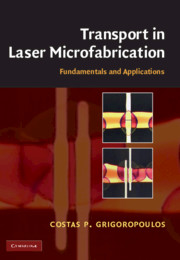Book contents
- Frontmatter
- Contents
- Preface
- 1 Fundamentals of laser energy absorption
- 2 Lasers and optics
- 3 Thermal processes in laser–materials interactions
- 4 Desorption at low laser energy densities
- 5 Dynamics of laser ablation
- 6 Ultrafast-laser interactions with materials
- 7 Laser processing of thin semiconductor films
- 8 Laser-induced surface modification
- 9 Laser processing of organic materials
- 10 Pulsed-laser interaction with liquids
- 11 Laser cleaning of particulate contaminants
- 12 Laser interactions with nanoparticles
- 13 Laser-assisted microprocessing
- 14 Nano-structuring using pulsed laser radiation
- Index
- References
13 - Laser-assisted microprocessing
Published online by Cambridge University Press: 04 December 2009
- Frontmatter
- Contents
- Preface
- 1 Fundamentals of laser energy absorption
- 2 Lasers and optics
- 3 Thermal processes in laser–materials interactions
- 4 Desorption at low laser energy densities
- 5 Dynamics of laser ablation
- 6 Ultrafast-laser interactions with materials
- 7 Laser processing of thin semiconductor films
- 8 Laser-induced surface modification
- 9 Laser processing of organic materials
- 10 Pulsed-laser interaction with liquids
- 11 Laser cleaning of particulate contaminants
- 12 Laser interactions with nanoparticles
- 13 Laser-assisted microprocessing
- 14 Nano-structuring using pulsed laser radiation
- Index
- References
Summary
Laser chemical vapor deposition
Consider a target material immersed in a reactive ambient medium. An incident laser beam may excite and dissociate the reactant molecules. Consequently, excited molecules or radicals diffuse to the solid surface and may interact with the target surface, resulting in etching or deposition. These processes are thoroughly discussed in Bäuerle (2000). Figure 13.1 gives a schematic illustration of the laser-induced chemical-processing systems utilizing either direct beam incidence onto the substrate or processing via a beam propagating in a direction parallel to the substrate. Thermal or pyrolytic chemical laser processing is characterized by the rapid dissipation of the excitation energy into heat. In this case, the particular excitation mechanisms are not significant and the processing rate is chiefly determined by the induced temperature distribution. However, the physicochemical processes involved may be drastically different from the conventional “thermal-processing” treatment. This is highlighted by the extremely confined laser-beam radiant energy and hence the temperature-distribution localization to high peak temperatures and steep temperature gradients. Furthermore, pulsed-laser-induced heating rates can be very fast, reaching 1012 K/s, even 1015 K/s, leading to a regime where the chemical reaction deviates greatly from equilibrium. Consequently, one may expect the formation of new phases, microstructures, and morphologies through novel chemical-reaction pathways. On the other hand, photochemical or photolytic laser chemical-processing conditions apply when the thermalization of the excitation energy is slow.
- Type
- Chapter
- Information
- Transport in Laser MicrofabricationFundamentals and Applications, pp. 350 - 375Publisher: Cambridge University PressPrint publication year: 2009

